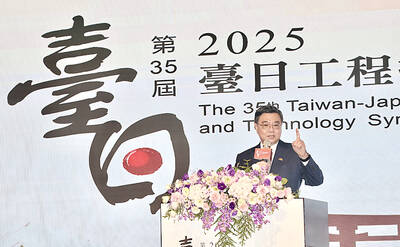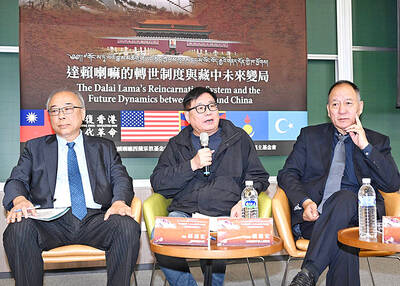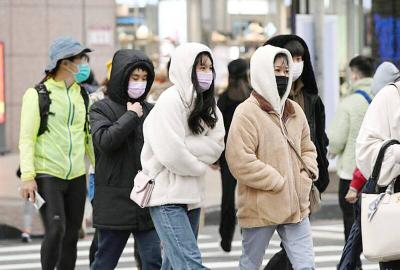Matsu’s “blue tears,” usually visible from April to September, were sighted as late as October this year due to a surprising reason: Chinese dredging, an ecologist said on Thursday.
Illegal dredging near Lienchiang County has kicked up nutrients and phytoplankton from the ocean floor, providing a favorable environment for the bioluminescent algae, also known as sea sparkle, a research team led by National Taiwan Ocean University professor Chiang Kuo-ping (蔣國平) has found.
The Matsu archipelago has in the past few years attracted many tourists who want to experience the blue tears, which have even made a CNN list of the top 15 natural scenic wonders of the world.

Photo courtesy of the Lienchiang County Government
Although sea sparkle might be seen throughout the spring and summer, its appearance relies on a number of criteria, Chiang said.
The algae require warm water ranging from 15°C to 24°C, making the late spring and early summer the optimal viewing time, he said.
However, it does not appear if the moon is too bright, or if the wind, currents, tide or topography is unsuitable, he added.
Research has shown that the bioluminescence is a natural phenomenon that originates in the Min River in China’s Fujian Province, Chiang said.
From April to June every year, runoff from melted snow flows down the swollen Min River, bringing with it inorganic nutrients such as nitrogen, silicon and phosphorus that phytoplankton feeds on, he said.
Of these phytoplankton that multiply with the influx of nutrients, diatoms are a main food source for the algae responsible for blue tears, he added.
The algae reproduce quickly due to this abundance of food, resulting in an algal bloom and the sea sparkle phenomenon, Chiang said.
Once the high-water season ends on the Min River, diatoms become less abundant and the bioluminescent algae fade along with it, he said.
This year, the blue tears were particularly plentiful — even into October — because of the nutrients dredged up from the ocean floor by Chinese vessels, Chiang said.
University president Hsu Tai-wen (許泰文) said that researchers at the school have found ways to cultivate sea sparkle, allowing visitors to view the phenomenon year-round at the Blue Tears Ecological Museum on Matsu’s Nangan Island (南竿).
The university in October established the Matsu Ocean Research Center dedicated to the research of marine environments and related industries, Hsu said.
The center is currently working on developing a smartphone app that would forecast when the blue tears are likely to appear, he added.
Lienchiang County Commissioner Liu Tseng-ying (劉增應) said that it is not easy to catch the blue tears, but if the conditions are right, it is an unforgettable experience.
The county council is working with the university on research and education related to sea sparkle, Liu said, adding that he is looking forward to a future in which visitors would know the right time to catch a glimpse of the blue tears.

ALIGNED THINKING: Taiwan and Japan have a mutual interest in trade, culture and engineering, and can work together for stability, Cho Jung-tai said Taiwan and Japan are two like-minded countries willing to work together to form a “safety barrier” in the Indo-Pacific region, Premier Cho Jung-tai (卓榮泰) yesterday said at the opening ceremony of the 35th Taiwan-Japan Modern Engineering and Technology Symposium in Taipei. Taiwan and Japan are close geographically and closer emotionally, he added. Citing the overflowing of a barrier lake in the Mataian River (馬太鞍溪) in September, Cho said the submersible water level sensors given by Japan during the disaster helped Taiwan monitor the lake’s water levels more accurately. Japan also provided a lot of vaccines early in the outbreak of the COVID-19 pandemic,

Kaohsiung Mayor Chen Chi-mai (陳其邁) on Monday announced light shows and themed traffic lights to welcome fans of South Korean pop group Twice to the port city. The group is to play Kaohsiung on Saturday as part of its “This Is For” world tour. It would be the group’s first performance in Taiwan since its debut 10 years ago. The all-female group consists of five South Koreans, three Japanese and Tainan’s Chou Tzu-yu (周子瑜), the first Taiwan-born and raised member of a South Korean girl group. To promote the group’s arrival, the city has been holding a series of events, including a pop-up

TEMPORAL/SPIRITUAL: Beijing’s claim that the next Buddhist leader must come from China is a heavy-handed political maneuver that will fall flat-faced, experts said China’s requirement that the Dalai Lama’s reincarnation to be born in China and approved by Beijing has drawn criticism, with experts at a forum in Taipei yesterday saying that if Beijing were to put forth its own Dalai Lama, the person would not be recognized by the Tibetan Buddhist community. The experts made a remarks at the two-day forum hosted by the Tibet Religious Foundation of His Holiness the Dalai Lama titled: “The Snow Land Forum: Finding Common Ground on Tibet.” China says it has the right to determine the Dalai Lama’s reincarnation, as it claims sovereignty over Tibet since ancient times,

Temperatures in some parts of Taiwan are expected to fall sharply to lows of 15°C later this week as seasonal northeasterly winds strengthen, the Central Weather Administration (CWA) said today. It is to be the strongest cold wave to affect northern Taiwan this autumn, while Chiayi County in the southwest and some parts of central Taiwan are likely to also see lower temperatures due to radiational cooling, which occurs under conditions of clear skies, light winds and dry weather, the CWA said. Across Taiwan, temperatures are to fall gradually this week, dropping to 15°C to 16°C in the early hours of Wednesday